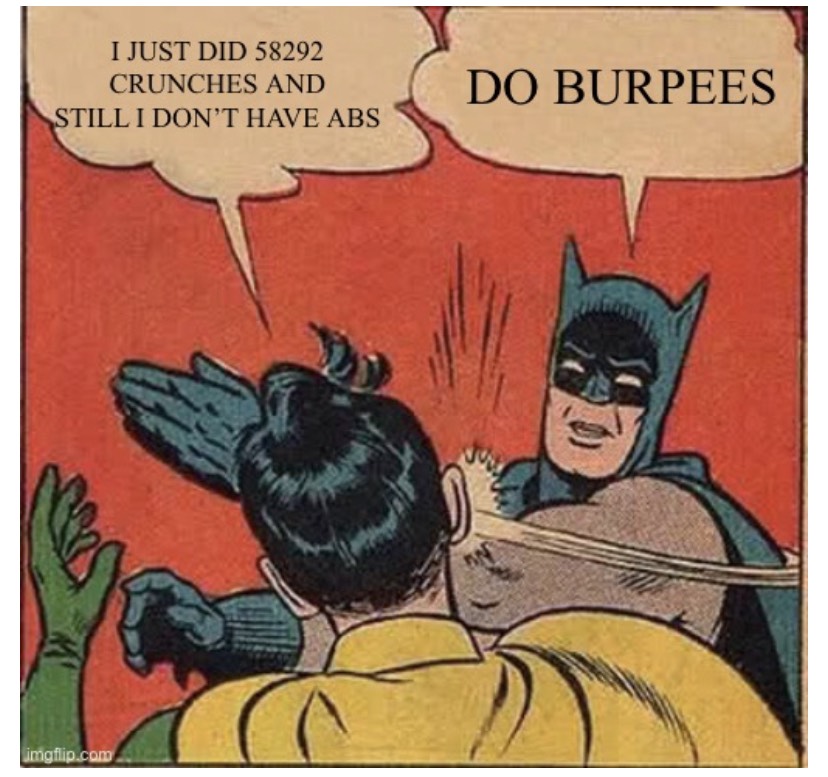5 Reasons Why Your Workout SUCKS (and How to Get the Best Out of Your Workout)
Share

Nothing is more frustrating than putting hours at the gym and meal prepping, but seeing little to no results. Meanwhile, you notice your friends who look good almost all year round and they might not be spending as much time as you are at the gym. Not fair, right?
Well, you need to work out smarter, not harder. If you want to know what you might be doing wrong (or not doing at all) around and during the time of your workout, then this article is for you.
Here are five workout-related behaviors you can improve on in order to achieve better outcomes:
1. Spot Reduction.
We all have that one friend who wants abs so badly that all they do at the gym are crunches and Russian twists. Science calls it localized, exercise-induced fat reduction or spot reduction. Here’s the deal – spot reduction does not work! Just think about it. Your body breaks down and mobilizes fat to fuel your workout. It doesn’t pick and choose from which body part. With the exception of very few studies, most research has shown more significant subcutaneous abdominal fat loss in the context of generalized circuit training. In order to get more toned arms or abdominal muscles, your overall body fat percentage has to drop. In conclusion, whole-body exercises are superior to isolation exercises.

2. Your workouts are not intense and/or you are not training enough.
Studies have shown that high-intensity interval training (HIIT), a short period (interval) of exercise followed by a resting interval, is superior to lengthy steady-state cardio exercises in terms of building stamina, endurance, and (you guessed it right) weight-loss. On the other hand, other studies demonstrated that moderate-intensity continuous training (MICT) and HIIT showed similarities in body composition improvement. So take your pick! But note that HIIT style training will indeed be more time-efficient.
3. Your form just sucks (sorry bro)!
Military Push-ups are hard. But if you are persistent (and perform them correctly), you will get enhanced muscle tone and strength in your pectorals, triceps, deltoids, and abs! Here’s what most people I have encountered do. Before mastering the basics of a movement, they move on to more advanced progressions targeting the same muscle group. Let’s stop here for a second. If you can barely do a push-up with good form, supporting 65% of your body weight with your upper body, how on earth will you be able to perform a progression such as hand-stand pushup supporting your 100% body weight? More so, a progression such as a handstand pushup requires coordination and balance that only come with hours of practice. Next time you train, seek input from a coach or an accountability buddy on your form. It might be a good idea to dial down on your exercises until you master the basics.
4. What’s in your pre-workout matters!
Everyone tells you that carbs are “bad”. Carbohydrates are your immediate and fastest source of energy. You will definitely notice a difference in performance when you are well-fed with quality foods that contain carbs. In addition to carbs, you want to include some protein. The average pre-or post-workout scoop contains roughly 20 g of protein, which is what your muscles need for performance and recovery. Lastly, you need just a little bit of fat. Consuming a fatty meal prior to working out will leave you sluggish and affect your performance. Other ingredients to look for in a pre-workout to help with your performance are creatine, caffeine, and branched-chain amino acids (BCAAs). A good example of a well-balanced pre-workout product that I have regularly used and recommended to my friends is PROGENEX More Muscle (Not a sponsored recommendation, it is purely based on personal preference).


Another important element is Hydration! Based on your activity level, your daily water intake should equal half of your body weight, in fluid ounces. Dehydration can impact both your daily energy level and performance. Lastly, when should you eat before a workout? Eat within 2-3 hours of your workout. If you have to eat on short notice, then pick a small-portioned meal that can be digested easily.
5. Your workouts are killer! But you are not consistent.
I personally know people who work out really hard but only 2 days a week. In order to see results such as weight loss, body fat reduction, faster performance, or better endurance, you need to constantly challenge yourself and your muscles. As a parent and a healthcare professional, I understand the time constraint. That being said, find yourself a routine that you can stick to 4-5X a week. The most recent exercise guidelines recommend moderate-intensity workouts for 150 minutes a week, or high-intensity workouts for 75 minutes a week. You may not have access to the gym 4-5X a week because of costs or commute, but you do have access to your living room or basement 24/7. You may be unable to work out with the same intensity on regular basis, but you can alternate days of light and more intense regimens. You may have to do some optimization based on how busy you are and when you need to rest, but find a way to keep consistent. This is the hardest part, folks. Set yourself up for success and plan your workouts around your resources and schedule, and stick to it NO MATTER WHAT!
If you are not a regular at exercise and still need some motivation, check out this interesting article on “5 Reasons to Exercise and None of them is to lose weight“. For regular fitness updates, follow my Insta handle – @mombodshreds.
References:
1. Kerksick, C., et al. (2008). International Society of Sports Nutrition position stand: nutrient timing. Journal of the International Society of Sports Nutrition, 5(1), 1-12. [Pubmed]
2. Kostek, M. A. et al. (2007). Subcutaneous fat alterations resulting from an upper-body resistance training program. Medicine & Science in Sports & Exercise, 39(7), 1177-1185. [Pubmed]
3. Miguet, M., Fearnbach et al. (2020). Effect of HIIT versus MICT on body composition and energy intake in dietary restrained and unrestrained adolescents with obesity. Applied Physiology, Nutrition, and Metabolism, 45(4), 437-445. [Pubmed]
4. Wewege, M. et al. (2017). The effects of high‐intensity interval training vs. moderate‐intensity continuous training on body composition in overweight and obese adults: a systematic review and meta‐analysis. Obesity Reviews, 18(6), 635-646. [Pubmed]
5. Mayo Clinic | Eating and exercise: 5 tips to maximize your workouts – Mayo Clinic. Accessed June 6, 2021.
6. Healthline | Is It Possible to Target Fat Loss to Specific Body Parts?. Accessed June 6, 2021.
7. Dietary Guidelines | 2015-2020 | health.gov. Accessed June 6, 2021.
8. Cover Photo Credit – Julia Larson
If you enjoyed our content, then please share, comment, like and follow us on your favorite platforms!
.
.

